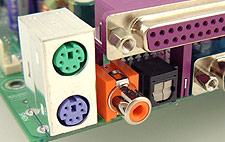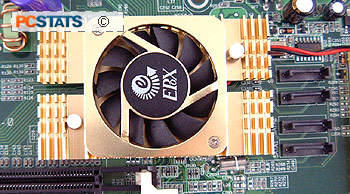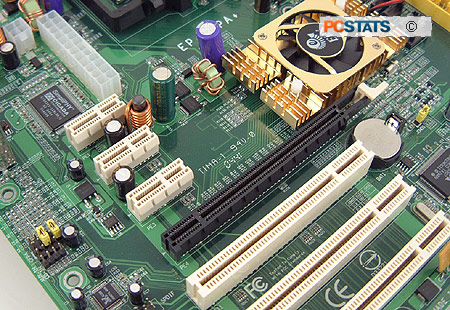 Round
back by the I/O ports, we don't find any Firewire jacks (common to most nForce 4
boards) but the EP-9NPA+ Ultra does have an
optical and composite SPSIF out. These digital audio connections allow users to hook
up the PC to a much more advanced sound system, without loosing quality by switching
modes.
Round
back by the I/O ports, we don't find any Firewire jacks (common to most nForce 4
boards) but the EP-9NPA+ Ultra does have an
optical and composite SPSIF out. These digital audio connections allow users to hook
up the PC to a much more advanced sound system, without loosing quality by switching
modes.
With the DDR memory slots so closely packed together,
we thought we might have problems installing Corsair's TwinX3200XL PRO memory - which has relatively thick
aluminum heatspreaders attached, but this was not the case.
 Thermally, motherboards
don't really produce any heat, but the chipsets on them certainly do. The biggest culprit aside from the MOSFETs, is
generally the northbridge. The EP-9NPA+ Ultra is based on nVidia's nForce4 Ultra chipset, and it
really does generate a lot of heat under operation.
Thermally, motherboards
don't really produce any heat, but the chipsets on them certainly do. The biggest culprit aside from the MOSFETs, is
generally the northbridge. The EP-9NPA+ Ultra is based on nVidia's nForce4 Ultra chipset, and it
really does generate a lot of heat under operation.
When the entire system is overclocked, this heat
can lead to instability, so we we're pleased to see that Epox have placed a
large active cooler on the chipset. During testing it got quite warm to the
touch, proof that the chipset itself gets rather toasty as well.
As we
mentioned, the list of onboard features for the EP-9NPA+ Ultra
gets all the necessary bases, but little else is included. There are no extra IDE ports
or SATA channels, only one GbE NIC, and the brackets to utilize the integrated USB2.0 and
firewire headers are not included in the retail package (the game console bracket
is however).

The board retails for about $165 CDN ($135 US), so
in that respect you really can't ask for the moon. Still, if you do need to
upgrade, there are three 32-bit PCI slots and three PCI Express x1
slots.
